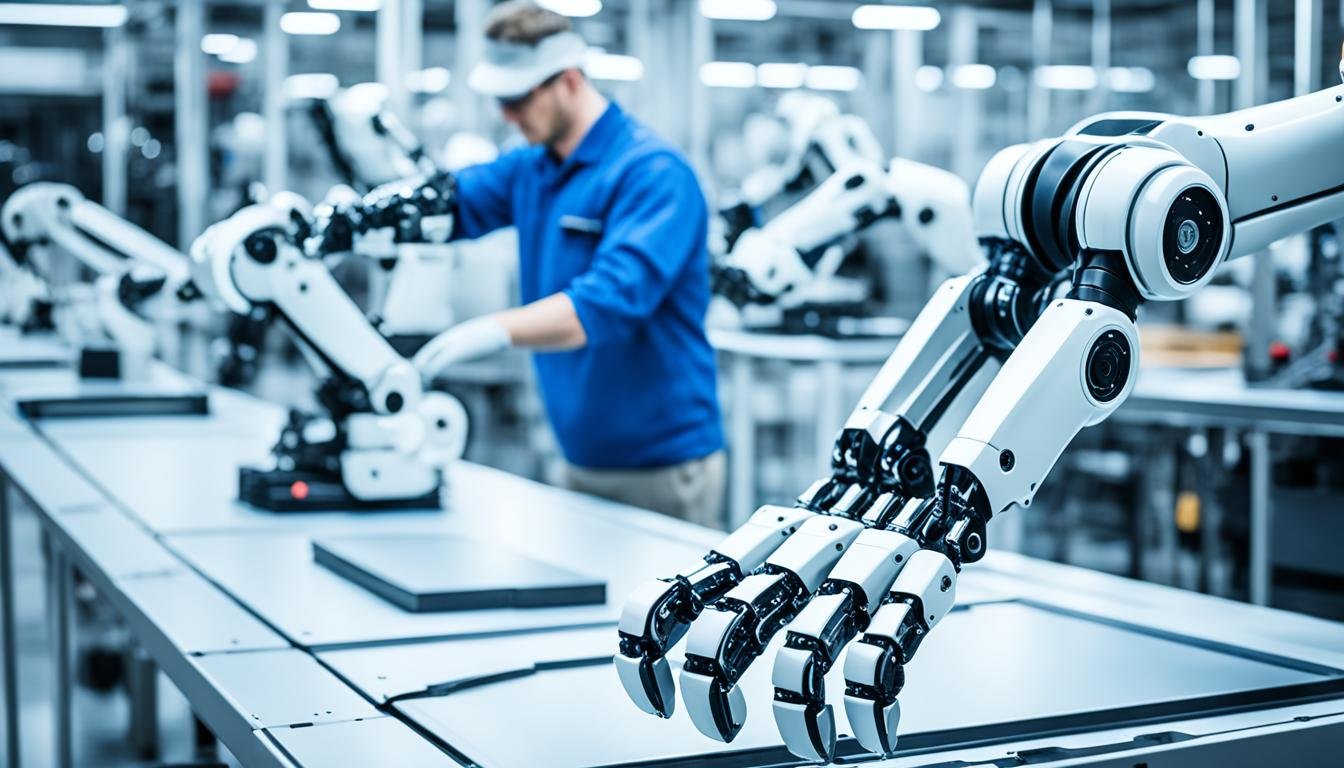A recent Goldman Sachs report says 18% of jobs worldwide could be lost to AI. This shows how big the change artificial intelligence could bring to our jobs. It’s important to see how AI will change work, the new chances it brings, and how to do well in the future.
Key Takeaways
- AI could potentially replace over 4.8 million American jobs, based on Bureau of Labor Statistics estimates.
- Certain occupations like customer service, copywriting, and data entry are more susceptible to automation by AI.
- However, AI is also creating new jobs and skill demands in areas like technical writing, translation, and AI-related roles.
- Adapting to the AI era requires proactive reskilling, cultivating complementary human strengths, and committing to continuous learning.
- Successful integration of AI in the workplace involves redesigning workflows, promoting transparency, and embracing ethical AI practices.
The Automation Revolution: Understanding AI’s Potential
The automation and AI revolution is changing how industries work. It’s important to understand how it will affect jobs. Automation means technology does tasks that humans used to do. This includes Robotic Process Automation (RPA) for simple tasks and AI-enabled systems like self-driving cars and medical diagnosis tools.
Differentiating Between Process Automation and Autonomous Systems
Most routine tasks are at risk from automation, but AI struggles with unpredictable work. Yet, AI is getting better at doing things on its own. A study looked at over 2000 jobs and found half could be automated, like data entry and simple physical tasks. But, jobs that need human skills and managing others are harder for AI to take over. Still, AI will change many jobs by making them easier for humans to do.
Jobs and Tasks Most Susceptible to Automation
About 51% of tasks across various industries are likely to be automated by AI. Jobs at high risk include customer service reps, drivers, and factory workers. But, new jobs will come up, like AI specialists and data analysts. As AI changes work, it’s important for people and companies to get ready for these changes.
“AI adoption has led to increased efficiency and scalability for businesses, facilitating tasks such as analyzing large data sets rapidly and crafting sales emails with speed.”
The AI workforce impact is clear, with 87% of companies using AI in some way. As AI changes work, it’s key for people and companies to keep up and be ready for what’s next.
will ai replace jobs
Many worry that AI will take over jobs, but the truth is more complex. Automation might change some jobs, but it also creates new ones. Fields like robotics, big data analytics, AI development, and cybersecurity are in high demand and pay well, showing the need for skilled workers.
Investing in technology can make us more productive and increase our earnings. This leads to more jobs being created. By understanding how automation affects jobs, we can plan better for the future.
Navigating the AI-Driven Shift
AI and automation might replace some jobs, but it’s not all bad news. A study found that generative AI systems could automate up to 70% of employee workloads. Yet, AI also brings new jobs and changes old ones in exciting ways:
- AI-powered chatbots and virtual assistants make customer service better.
- Generative design tools are changing engineering and graphic design.
- Automated data analysis and reporting cut down on entry-level analytical jobs.
Even as some jobs change, AI helps workers focus on harder and more interesting tasks. This can make us more productive and open up new chances for work.
Embracing the AI-Driven Future
We need to get ready for the changing job market by learning new skills. By working with AI and always learning, we can move forward and find new opportunities in tech.
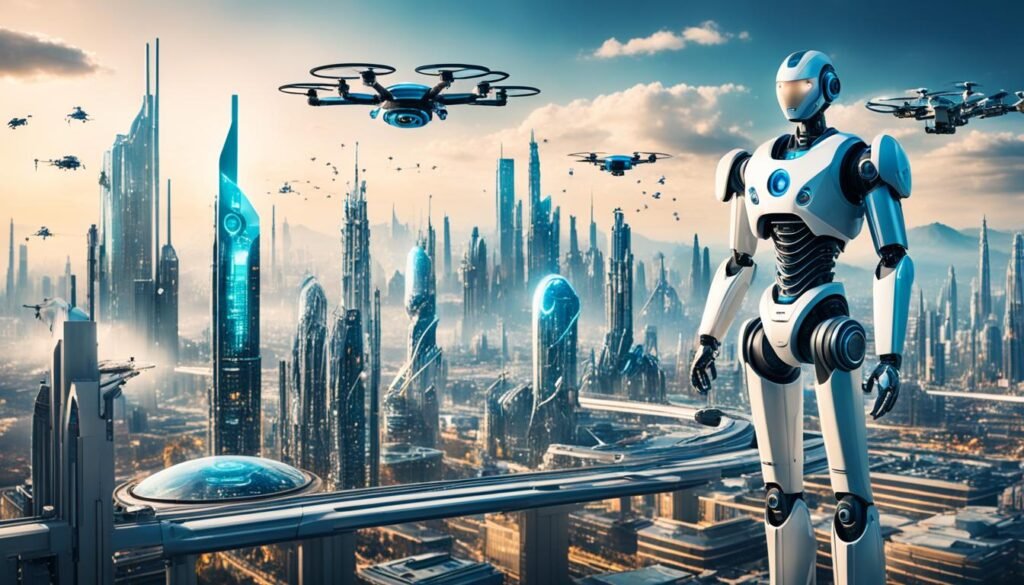
The future of work will depend on how well we adapt and use AI’s potential. By understanding the changes AI brings, we can build a strong and successful workforce for the AI age.
Adapting the Workforce for the AI Era
Automation is changing jobs fast, making some jobs less needed while creating new ones. Companies need to train workers for the future of work and AI. Working together, being open, and doing things right can make this change smoother.
AI could add about $13 trillion to the world’s economy by 2030, making it 16% bigger than today. By then, 70% of companies will use AI, but only half will fully use five main AI types.
But, AI also brings big challenges. It might replace up to 300 million jobs worldwide. In the US and Europe, a quarter of work tasks could be automated. Researchers say two-thirds of jobs in these areas could see AI take over some tasks, and a quarter could be done by AI alone.
To lessen the blow of ai workforce impact, companies should focus on ai reskilling. A report from MIT and Boston University says AI might replace up to two million manufacturing workers by 2025. By 2030, at least 14% of workers globally might need new careers because of AI and other tech changes.
“Some educated white-collar workers earning up to $80,000 a year are considered the most likely to be impacted by workforce automation.”
Training workers now can help them keep up with AI. Teaching skills like creativity, emotional smarts, and critical thinking can make them valuable. By encouraging learning, companies can help their workers adjust and do well with new tech.
Dealing with the future of work and ai needs a team effort. Companies should talk with their workers, listen to them, and use AI wisely. By changing how work is done and being open, employers can gain trust and make the change easier for everyone.
We need to find a way to use AI’s power while protecting workers’ jobs. Training workers, focusing on skills AI can’t replace, and encouraging learning can help. This way, companies can help their workers succeed in an AI world.
Cultivating Human-AI Collaboration
The impact of AI is changing the workforce. The key to handling this change is cultivating human-AI collaboration. By working together, people and machines can improve productivity and open new growth paths.
Proactive Reskilling
Seeing jobs that might need new skills helps us prepare. Workers can learn new skills in areas like digital tech through programs or online resources. This helps reduce the risk of losing skills and brings more talent to growing fields.
It also helps people move up in their careers, especially those in low-wage jobs. This is good for workers and industries alike.
Cultivating Complementary Human Strengths
Instead of competing with AI in tasks like logic and math, workers should focus on human strengths, such as creativity, social skills, and judgment. By learning new skills, workers keep their value as AI takes over routine tasks.
Committing to Continuous Learning
With technology changing so fast, one-time skill programs won’t be enough. Workers need to keep learning through short courses, online training, and working with peers. Companies that support ongoing learning with things like tuition help and time off for training do well.
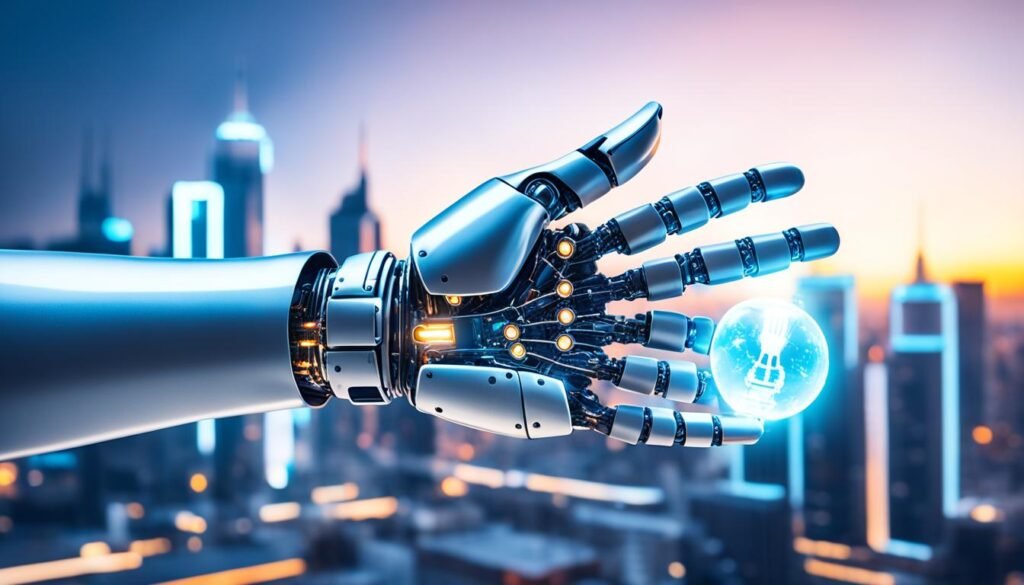
“Research involving 1,500 firms in various industries shows that companies that automate operations mainly to reduce their workforces will experience only short-term productivity gains. Companies achieve the biggest performance improvements when humans and smart machines collaborate.”
Redesigning Workflows for Seamless Automation
As we move forward with the future of work and AI, it’s key to rethink our workflows. Automating tasks without thinking about the bigger picture can lead to problems. By looking at the whole workflow, we can find new spots where human judgment is needed.
Redesigning Workflows Alongside Automation
Getting key people involved in redesigning workflows helps us understand each other better. This teamwork ensures that AI and automation fit well with what the workforce and the company need.
Promoting Transparency in AI Implementation
Telling everyone about the plans, how it will affect jobs, and the support available can stop worries. Showing how AI helps workers can ease fears of losing jobs. This makes the benefits of working with AI clearer.
By planning workflows ahead and being open, companies can lead the way in a future where future of work and ai, ai workforce impact, and ai labor disruption are handled with care and teamwork. This approach benefits both employees and the business.
“The key to success in the AI-powered future of work lies in embracing a collaborative approach, where humans and machines work in tandem to optimize workflows and unlock new possibilities.”
Embracing Ethical AI Practices
The future of work and ai is changing fast. It’s key for companies to use ethical ways when adding ai workforce impact and ai labor disruption steps. Knowing the daily challenges of workers helps make automation better. It also helps ease worries and gives a sense of control over changes.
Leaders need to mix these ideas well. They should think about work needs, ethics, and worker welfare. Getting workers involved makes automation feel like a team effort. This builds ownership and support.
Incorporating Worker Feedback in Automation Initiatives
Workers have great insights for making future of work and ai plans work. By setting up ways for workers to share ideas, companies can use this knowledge well. This makes sure automation meets the specific needs of the workers.
- Encourage open talks and give many ways for workers to share their thoughts and worries.
- Listen to what workers say and show you’re willing to use their ideas in the automation plan.
- Build a team culture where workers feel they can help make decisions.
Ensuring Responsible and Ethical AI Practices
ai workforce impact brings big gains but also risks like bias and data safety issues. To deal with these, companies must focus on ethical AI use.
- Put in strong rules to stop misuse and protect society and the company’s image.
- Keep humans in charge of AI decisions that affect people’s lives.
- Spot and fix ethical risks, making sure important choices are made by humans.
By using ethical AI and listening to workers, companies can move through the ai labor disruption with confidence. This empowers the workforce and creates a team environment ready for the future.
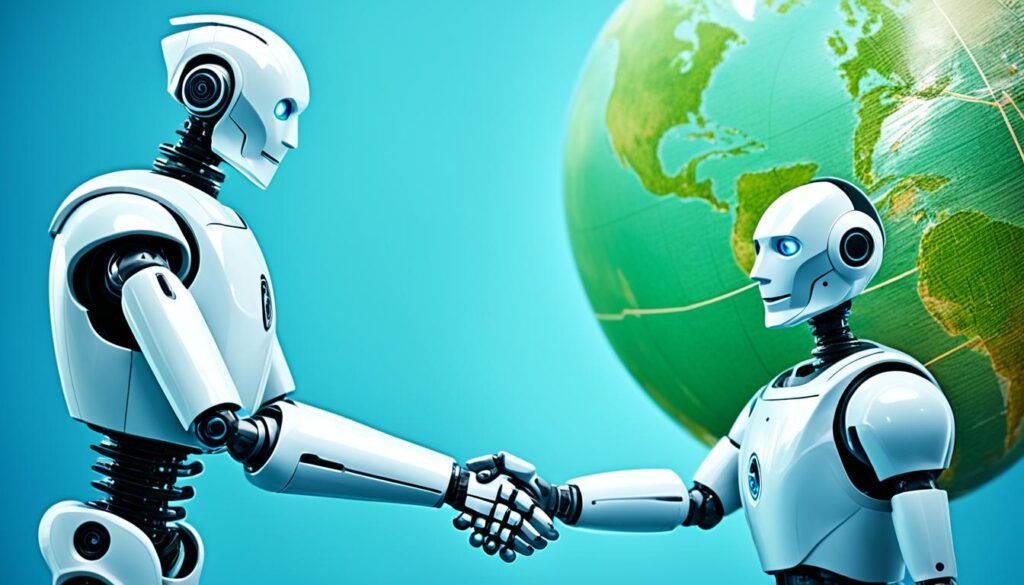
The Future of Work: Striking a Balance
The world is at a turning point as it welcomes the power of artificial intelligence (AI). The future of work and ai brings new progress and efficiency. But, we must think carefully about how technology and human skills work together.
AI has changed many industries, making them more productive and efficient. Yet, we must remember that people are key to success. Their creativity and motivation drive innovation more than machines can. To keep up with AI, we need to improve our skills, focus on what humans do best, and keep learning.
- 30% of workers worldwide worry that AI might take their jobs in the next three years.
- In India, 74% of workers are worried about AI replacing their jobs.
- AI could replace about 800 million jobs worldwide by 2030.
The future of work and ai isn’t a battle between humans and machines. It’s about finding the right balance and using both to their strengths. By using AI ethically, designing better workflows, and promoting teamwork with AI, companies can make the most of this new era.
“The true measure of progress is not how fast machines can replace people, but how well people can leverage machines to enhance their own potential.”
As the ai workforce impact changes the job market, it’s important for employers and employees to move forward together. They need to be adaptable and committed to working well with AI for everyone’s success.
Real-World Case Studies: Human-AI Synergy
In today’s world, the ai workforce impact and the future of work and ai are changing how humans and AI work together. We’ll look at examples that show how these two forces are making a big difference. They’re showing us how companies are using automation and still supporting their workers.
In warehouses and farms, AI has changed how things get done. AI helps with hard tasks, but people are still key for planning and using their EQ to work well with others. This mix of AI’s accuracy and human smarts has led to big wins, proving the power of working together.
In creative fields, AI and humans are making amazing things happen. AI does the easy tasks, letting people work on harder, more creative projects. These projects need EQ and thinking on your feet, things AI isn’t good at yet.
Humans and AI work well together in many areas, not just in making art. In HR, AI has changed how we handle paperwork, making work better for employees. AI can make training personal, but people are still needed to check facts and guide AI.
“AI is only as good as the data human workers feed it or create for it, indicating the importance of human input in guiding AI to give accurate insights.”
These examples show that the future of work and ai isn’t about replacing people. It’s about making them better with ai workforce impact. By using the best of both humans and AI, companies can do more, innovate more, and succeed more.
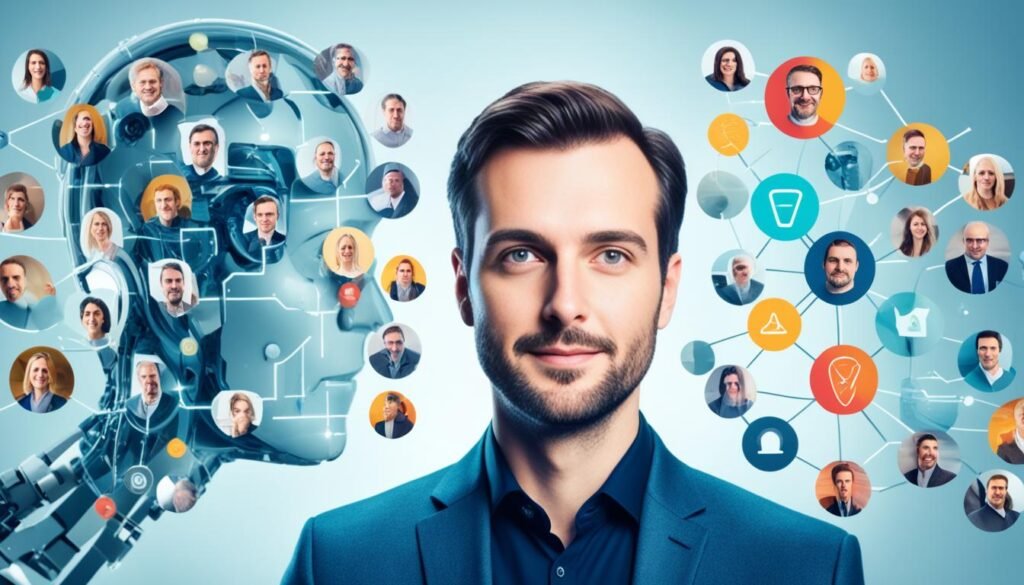
Navigating the Transition: Policy Considerations
As the future of work changes with ai job displacement and ai labor disruption, policymakers need to act. They must find ways to make the change easier and fair for everyone. The future of work and ai requires us to work together and plan ahead for the effects of new technology.
One important idea is to use a conditional basic income (CBI). CBI would help workers who lose their jobs due to AI automation. It would make sure they have enough money to live on while they learn new skills. This way, CBI would help people move into new careers and adjust to the future of work and ai.
Along with CBI, we need strong programs to help workers learn new skills. Governments and companies should put money into training programs. These could include helping people pay for school, giving tax breaks for training at work, and working together to create training programs for specific industries.
Also, we should encourage companies to use human-centric automation. By giving tax breaks or other rewards to businesses that use AI to help workers, not replace them, we can make sure ai job displacement is kept low. This way, we can manage ai labor disruption better.
| Policy Measure | Objective | Potential Impact |
|---|---|---|
| Conditional Basic Income (CBI) | Provide a safety net for displaced workers and incentivize reskilling | Empowers workers to adapt to the changing job market, mitigates income inequality |
| Workforce Retraining Initiatives | Equip workers with the necessary skills for an AI-powered economy | Enhances employability, fosters a more resilient and adaptable workforce |
| Incentives for Human-Centric Automation | Encourage businesses to integrate AI and automation in a way that complements human labor | Minimizes ai job displacement, promotes a balanced future of work and ai |
By tackling the issues of ai job displacement and ai labor disruption early, policymakers can help us move into an AI-filled future of work. They can make sure the good things about new technology are shared by everyone in the workforce.
Conclusion
The fast growth of artificial intelligence and automation is changing the future of work. It’s important to use these technologies in a way that works for everyone. By doing this, you can bring new ideas, grow the economy, and create jobs while tackling the challenges they bring.
To keep up with the AI-powered future, you need to keep learning and use your unique human skills. By balancing what humans and machines can do, we can make a better and fairer future. This means thinking about will ai replace jobs, future of work and ai, and ai workforce impact carefully.
It’s key to use AI in an ethical way, listen to workers, and make sure it’s done right. This way, we can get the most out of AI and automation while avoiding its downsides. With teamwork and smart policies, we can make a future where technology and human creativity work together. This will make the world better for everyone.
FAQ
What is the estimated impact of automation and AI on jobs?
Some experts say up to 47% of U.S. jobs could be at risk from automation. Others think the impact might not be as big as feared. While many routine tasks will be taken over by machines, new jobs will pop up in areas like robotics and data analysis.
How can workers adapt to the changing job market due to AI and automation?
Workers should keep learning new skills that AI can’t easily do. This means getting better at things like creativity and social skills. Taking online courses, practicing with virtual tools, and getting advice from peers can help keep workers ahead in the changing job world.
What is the role of organizations in supporting their workforce through the AI transition?
Companies need to be open and work together when bringing in automation. They should figure out which jobs will change the most, offer training, and help workers adjust to new tasks. By encouraging a culture of learning and teamwork, companies can help their workers succeed in the AI age.
How can policymakers help ease the transition to an AI-driven economy?
Lawmakers could look into things like basic income support, training programs, and rewards for companies that focus on people. The aim is to make sure everyone benefits from new technology in a fair way.
What are the ethical considerations around the use of AI in the workplace?
It’s important to use AI in a way that’s fair and doesn’t unfairly harm workers. This means making sure AI doesn’t show bias or create security risks. Keeping humans in charge and open about AI decisions is key.
